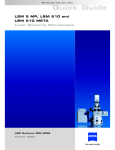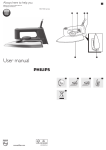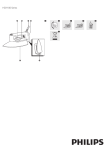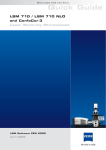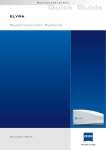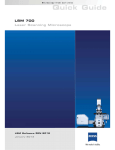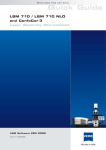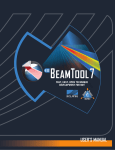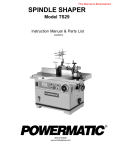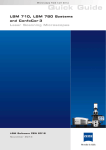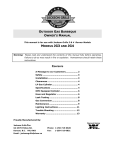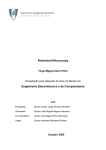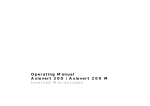Download information on this system.
Transcript
CB&IACore The University of Ottawa CB&IACore Facility Facility Zeiss LSM 510/ AxioImager.M1 Confocal Microscope Objectives Zeiss LSM 510 Axio Imager M1 Microscope Objectives Room: 4502 1 2 3 EC Plan-Neofluar 10x Plan-Apochromat 20x EC Plan-Neofluar 40x 0.3 0.8 1.3 Oil Magnification 10x 20x 40x Numerical Aperture 0.3 0.8 1.3 Working Distance (mm) 5.2 0.55 0.21 Coverglass (mm) 0.17 0.17 0.17 Immersion None None Oil ICS ICS ICS Flatness **** ***** **** Color Correction **** ***** **** UV Transmission **** *** **** IR Transmission *** **** *** (not equipped) **** (DIC II) ***** DIC III 420340-9901 420650-9901 420460-9900 4 5 6 Plan-Apochromat 63x Achroplan 40x W Plan Apochromat 63x 1.4 Oil 0.8 W 1.0 VIS-IR Magnification 63x 40x 63x Numerical Aperture 1.4 0.8 1 Working Distance (mm) 0.19 2.1 2.1 Coverglass (mm) 0.17 0 0 Immersion Oil Water Water Optical System ICS ICS ICS Flatness ***** ** ***** Color Correction ***** *** ***** UV Transmission *** ** *** IR Transmission **** *** **** DIC DIC III (DIC III) *** (DIC III) ***** 420780-9900 440090-9901 421480-9900 Optical System DIC Catalog # Catalog # ICS=Infinity Color Corrrected System Filter Sets Zeiss LSM510 AxioImager.M1 Microscope Filter Sets Room 4502 1. Transmitted Light 2. Zeiss Filter Set 02 (DAPI) Excitation: G 365 Beam Splitter: FT 395 Emission: LP 420 3. Chroma Filter Set 49001 (CFP) Excitation: BP 436/20 Beam Splitter: FT 455 Emission: BP 480/40 Similar to Zeiss Filter Set 47 4. Chroma Filter Set 49002 (GFP) Excitation: BP 470/40 Beam Splitter: FT 495 Emission: BP 525/50 Similar to Zeiss Filter Set 38 5. Chroma Filter Set 49003 (YFP) Excitation: BP 500/20 Beam Splitter: FT 515 Emission: BP 535/30 Similar to Zeiss Filter Set 46 6. Zeiss Filter Set 45 (Cy3.5/mcherry) Excitation: BP 560/40 Beam Splitter: FT 585 Emission: BP 630/75 Filter Sets https://www.micro-shop.zeiss.com/?p=us&f=f, http://www.chroma.com/products/catalog/49000_Series/ Filter Sets https://www.micro-shop.zeiss.com/?p=us&f=f, http://www.chroma.com/products/catalog/49000_Series/ Filter Sets https://www.micro-shop.zeiss.com/?p=us&f=f, http://www.chroma.com/products/catalog/49000_Series/ Microscope Quick Guide Zeiss LSM 510 AxioImager.M1 Microscope Guide (ZEN) Room 4502 Start Up Procedure 1. 2. 3. 4. 5. 6. 7. 8. Remove dust cover from microscope Toggle X-Cite Lamp switch ON On Remote Control Pad, toggle the System/PC switch and the Components switch ON Always leave Power Supply 231 switch ON position Turn Computer ON User name: New User (no password) Open program: ZEN 2009 Press Start System button to initialize hardware Lasers 1. Click Acquisition tab. Under Setup Manager heading, click on Lasers to open the lasers tool 2. Turn on the required laser(s) for your study: - To turn on the Argon/2 laser select Standby first. Click on laser properties at bottom of the Laser Tool. After about 1 minute of warming up, status will change from warming up to ready. Change Output (%) to 50. Select On. - The HeNe543 and HeNe633 lasers can be turned on directly by selecting On Configuring Microscope Mode 1. You can load pre-configured tracks in the Imaging Setup Tool. Click on the open icon to select an optical track. To add another track, click the + button to add a new empty track, and then use the open icon to select a pre-configured track to replace the empty track. 2. Open the Light Path Tool. You can toggle between the different tracks found in the Imaging Setup Tool to view the respective optical configuration in the Light Path Tool 3. For each track, click on Lasers button found in the Light Path Tool, and set the desired %Transmission for each Laser. Recommended: - Argon/2: 5-10% - HeNe633: 5-10% - HeNe543: 50-80% 1 Microscope Quick Guide Configuring Scan Parameters 1. Open the Acquisition Mode Tool located under the Online Acquisition heading 2. Select the appropriate objective from the drop down list 3. Select the appropriate Frame Size ie 1024x1024 o OR click Optimal button to get a frame size appropriate for Nyquist Sampling 4. Select the appropriate Scan Speed ie 5 – 9 5. For Averaging (to increase Signal/Noise ratio): - Number: 2 or 4 - Bit Depth: Set as desired - Mode: Line - Direction: - Method: Mean Set Sample on Stage and Focus 1. To be able to view specimen down ocular, need to first click Occular Tab, then Online 2. Lightly wipe your slide (on both sides) with a kimwipe and a small amount of 70% ethanol to clean. If using an oil lens, add a very small drop of immersion oil 3. Set slide on stage, bring specimen into focus and select desired area of interest 4. Click on Acquisition tab Adjusting Channels and Capturing an Image 1. 2. 3. 4. Open the Channels Tool found under the Online Acquisition heading For each channel, set the pinhole size to correspond to 1 Airy Unit as a starting point Adjust the pinhole sizes to get the same resulting optical section thickness across all channels Perform the following for each individual channel (temporarily deactivate other channels): - Click Live button to get a preview image - For the Range Indicator, click on the Channel Color, found under your image window o Red = saturated, Blue = zero pixels - Adjust your Gain (Master) such that a bit of red (overexposure) is seen, and then adjust the Digital Offset so that minimal blue (zero pixels) is obtained - Click Stop button 5. Once all channels have been adjusted, re-activate all of your channels/tracks 6. Click Snap to capture your final image 2 Microscope Quick Guide To Capture a Z-stack 1. 2. 3. 4. 5. Check the Z-stack option in the main tools area Open the Z stack Tool found under the Multidimensional Acquisition heading Make sure that First/Last mode is selected Click on Live button to get a preview image (with only one active track) Turn Fine Focus knob CW to an optical plane for starting Z-stack capturing, and click Set First button 6. Turn Fine Focus knob CCW to an optical plane to be the last optical section of the Z-stack and click Set Last button 7. Click Stop button 8. Re-activate all of your channels 9. Click on the button to set number of slices to match the optimal Zinterval for a given stack size, objective lens, and pinhole diameter 10. Click on the button to start acquiring your Z-stack To Save an Image 1. To save an image, click File, Save as or click the button in the Main Toolbar, or the button in the File Handling Area. 2. Enter a file name, select the LSM 5 (.lsm) format, and press Save Reuse Button 1. To capture a new image using the exact acquisition parameters (pinhole diameter, Gain (Master), Digital Offset, excitation, beam path, scan mode, frame size, speed, data depth, scan direction, average, zoom) of an existing image, click Reuse button on the bottom panel of an opened image 2. The acquisition parameters of a displayed image can be viewed by clicking on Info button on the left of the image Shut Down Procedure 1. If used oil lens, thoroughly remove oil using dry Lens Paper 2. Put 10x objective in place 3. Put Argon laser on standby, but leave other lasers on Continue if last user: 4. From the Lasers Tool, turn lasers OFF 5. Close the ZEN program 6. Shut down computer. Wait for computer to turn off 7. Always leave Power Supply 231 Box switch ON 8. On Remote Control Pad, toggle the System/PC switch and the Components switch OFF 9. Toggle X-Cite Lamp switch OFF 10. Cover microscope with dust cover 3 Microscopy from Carl Zeiss Quick Guide LSM 5 MP, LSM 510 and LSM 510 META Laser Scanning Microscopes LSM Software ZEN 2009 October 2009 We make it visible. Contents Page Contents ................................................................................................................................. 1 Introduction............................................................................................................................ 1 Starting the System ............................................................................................................... 2 Introduction to ZEN – Efficient Navigation .......................................................................... 5 Setting up the microscope................................................................................................... 10 Configuring the beam path and lasers ............................................................................... 12 Scanning an image............................................................................................................... 15 Storing and exporting image data ..................................................................................... 20 Switching off the system..................................................................................................... 21 Introduction This LSM 510 / LSM 510 META / LSM 510 NLO Quick Guide describes the basic operation of the LSM 510 / LSM 510 META / LSM 510 NLO Laser Scanning microscope with the ZEN 2009 software. The purpose of this document is to guide the user to get started with the system as quick as possible in order to obtain some first images from his samples. This Quick Guide does NOT replace the detailed information available in the full user manual or in the manual of the respective microscopes (Axio Imager, Axio Observer, Axioskop 2 FS MOT). Also, this Quick Guide is written for a user who is familiar with the basics of Laser Scanning Microscopy. For your safety! Observe the following instructions: The LSM 510 / LSM 510 META / LSM 510 NLO laser scanning microscope, including its original accessories and compatible accessories from other manufacturers, may only be used for the purposes and microscopy techniques described in this manual (intended use). In the Operating Manual, read the chapter Safety Instructions carefully before starting operation. Follow the safety instructions described in the operating manual of the microscope and X-Cite 120 lamp / HBO 100 mercury lamp. 10/2009 1 Starting the System Switching on the LSM system ! When set to ON the REMOTE CONTROL switch labeled System/PC provides power to the computer. This allows use of the computer and ZEN software offline (Fig. 1). ! To completely switch on the system, now press the Components switch to ON. This starts the other components and the complete system is ready to be initialized by the ZEN software. Switching on the X-Cite 120 or the HBO 100 mercury lamp Fig. 1 REMOTE CONTROL switch ! Switch on the main switch of the X-Cite 120 / HBO 100 lamp for reflected light illumination via the power supply as described in the respective operating manual. Switching on the Enterprise UV-Ar Laser ! If the UV laser is required, switch it on via the toggle switch (Fig. 2/1) on the power supply. It will be ready for operation after a few seconds. Fig. 2 2 Power supply of UV-Ar laser 10/2009 Starting the ZEN software ! Double click the ZEN 2009 icon on the WINDOWS desktop to start the Carl Zeiss LSM software. The ZEN Main Application window and the LSM 510 Startup window appear on the screen (Fig. 3) Fig. 3 ZEN Main Application Window at Startup (a) and the LSM 510 Startup Window (b and c) In the small startup window, choose either to start the system (Start System hardware for acquiring new images) or in Image Processing mode to edit already existing images. Toggle the little view the Boot Status display and get the additional Offline / Demo button option: symbol to Choosing Start System initializes the whole microscope system and activates the entire software package for new image acquisition and analysis. The Image Processing mode ignores all hardware and activates only data handling and image processing functionality for already acquired images. The Offline / Demo mode reads the current hardware database but does not activate the system hardware for use. Instead, it simulates the system hardware for training purposes. Upon clicking the Start System button, the Image Processing button changes to a Cancel button. Click Cancel to interrupt/stop the Startup of the system. After Startup, the ZEN Main Application window (Fig. 4 and Fig. 5) opens. To benefit from all of Zen's features, run the window in its full screen mode. 10/2009 3 4 Fig. 4 ZEN Main Application window after Startup with empty image container Fig. 5 ZEN Main Application window after Startup with several images loaded 10/2009 Introduction to ZEN – Efficient Navigation The ZEN 2009 interface is clearly structured and follows the typical workflow of the experiments performed with confocal microscopy systems: On the Left Tool Area (Fig. 4/D) the user finds the tools for sample observation, image acquisition, image processing and system maintenance, easily accessible via four Main Tabs (Fig. 5/1). All functions needed to control the microscope can be found on the Ocular Tab, to acquire images use the Acquisition Tools (Fig. 5/3 and 4). Arranged from top to bottom they follow the logic of the experimental workflow. The area for viewing and interacting with images is centered in the middle of the Main Application Window: the Center Screen Area. Each displayed image can be displayed and/or analyzed with many view options available through view tabs which can be found on the left side of the image. According to the chosen view tab, the required view controls appear in View Control Tabs below each image. File management and data handling tools are found in the Right Tool Area (see Fig. 4 and Fig. 5). Color and brightness of the interface have been carefully adjusted to the typical light conditions of the imaging laboratory, guaranteeing optimal display contrast and minimal stray light for high-sensitivity detection experiments. The ZEN software is optimized for a 30" TFT monitor but can also be used with dual-20" TFT setups. Fig. 6 Basic and Pro Mode A focus in the development of ZEN 2009 was to fulfill the needs of both basic users and microscopy specialists. Both types of users will appreciate the set of intuitive tools designed to make the use of a confocal microscope from Carl Zeiss easy and fast: The Show all concept ensures that tool panels are never more complex than needed. With Show all deactivated, the most commonly used tools are displayed. For each tool, the user can activate Show all mode to display and use additional functionality (Fig. 6). 10/2009 5 Fig. 7 ZEN Window Layout configuration More features of ZEN 2009 include: ! The user can add more columns for tools to the Left Tool Area or detach individual tools to position them anywhere on the monitor. To add a column, drag a tool group by the title bar (e.g., "Online Acquisition") to the right and a new tool column automatically opens. Alternatively use the context menu "move toolgroup to next column". To detach a tool, click on the little icon on the very right end of the blue tool header bar (Fig. 7). ! Another unique feature in Imaging Software is the scalable ZEN interface. This Workspace Zoom allows adjustment of the ZEN 2009 window size and fonts to the situational needs or your personal preferences (Fig. 7). ! Setting up conventional confocal software for a specific experiment can take a long time and is often tedious to repeat. With ZEN these adjustments have to be done only once – and may be restored with just two clicks of the mouse. For each type of experiment one can now set-up and save the suitable Workspace Layout. These configurations can also be shared between users. ! For most controls, buttons and sliders, a tool tip is available. When the mouse pointer is kept over the button, a small pop-up window will display which function is covered by this tool/button. These are just some of the most important features of the ZEN interface. For a more detailed description of the functionality for the ZEN 2009 software, please refer to the User Manual that is provided with your system. 6 10/2009 Setting up a new image document and saving your data To create a new image document in an empty image container, click the Snap Auto Exposure button. For an empty image document press the New or the button. The new document is immediately presented in the Open Images Area. Remember, an unsaved 2D image in the active image tab will be over-written by a new scan. Multi-dimensional scans or saved images will never be over-written and a new scan will then automatically create a new image document. Acquired data is not automatically saved to disc. Make sure you save your data appropriately and back it up regularly. The ZEN software will ask you if you want to save your unsaved images when you try to close the application with unsaved images still open. There is no "image database" any more like in the earlier Zeiss LSM software versions. Fig. 8 10/2009 New image document in the Open Images Ares 7 Advanced data browsing is available through the ZEN File Browser (Ctrl F or from the File menu). The File Browser can be used like the WINDOWS program file browser. Images can be opened by a doubleclick and image acquisition parameters are displayed with the thumbnails (Fig. 9). For more information on data browsing please refer to the detailed operating manual. Fig. 9 8 File Browser 10/2009 Turning on the lasers ! To manually switch lasers on or off open the Laser tool. ! All available lasers can be operated within this tool (Fig. 10). Fig. 10 10/2009 Laser Control tool 9 Setting up the microscope Changing between direct observation, camera detection and laser scanning mode The Ocular, Camera and LSM Acquisition buttons switch between the use of the LSM and the microscope the beam path and indicate which beam path is currently in use for the microscope: ! Click on the Ocular button to change open the controls for the microscope beam path and for direct observation via the eyepieces of the binocular tube, lasers are blocked. ! To set the hardware in position for using the microscope, click Online if not yet active. ! To close the light shutters on the microscope click Offline. ! Click on the LSM Acquisition button to move back to the LSM system. Setting up the microscope and storing settings Click on the Ocular tab for direct observation; press the Online button for your actions to take effect immediately. Then open the Ocular tool to configure the components of your microscope like filters, shutters or objectives (Fig. 11). Selecting an objective ! Open the graphical pop-up menu by clicking on the Objective symbol and select the objective lens for your experiment (Fig. 11). ! The chosen objective lens will automatically move into the beam path. Focusing the microscope for transmitted light ! Open the graphical pop-up menu by clicking on the Transmitted Light icon (Fig. 12). Fig. 11 Microscope Control window, e.g.: Axio Imager.Z1 ! Click on the On button. Set the intensity of the Halogen lamp using the slider. ! Clicking outside the pop-up control closes it. ! Place specimen on microscope stage. The cover slip must be facing the objective lens. Remember the immersion medium if the objective chosen requires it! 10 10/2009 ! Use the focusing drive of the microscope to focus the object plane. ! Select specimen detail by moving the stage in X and Y using the XY stage fine motion control. Setting the microscope for reflected light ! Click on the Reflected Light icon to open the X-Cite 120 controls and turn it on. ! Click on the Reflected Light shutter to open the shutter of the X-Cite 120 lamp / HBO100. ! Click on the Reflector button and select the desired filter set by clicking on it. Storing the microscope settings Microscope settings can be stored as configurations (Fig. 13) by typing a config name in the pull down selector and pressing the save button. Fast restoration of a saved config is achieved by selecting the config from the pull load button. The down list and pressing the current config can be deleted by pressing the delete button. Fig. 12 Microscope Control window with Transmitted Light pop-up menu Fig. 13 Configuration panel These configurations can be assigned to buttons that are easier to press. Depending on the microscope configuration, settings must be done manually if necessary. 10/2009 11 Configuring the beam path and lasers ! Click on the Acquisition button. Setting up a configuration Simultaneous scanning of single, double and triple labeling: Advantage: faster image acquisition Disadvantage: Eventual cross-talk between channels Sequential scanning of double and triple labeling; line-by-line or frame-by-frame: Advantage: Only one detector and one laser are switched on at any one time. This reduces crosstalk. Disadvantage: slower image acquisition ! Open the Imaging Setup and the Light Path tool in the Setup Manager Tool group to access the hardware control window to set-up the beam path. The open Light Path is shown in Fig. 14. " Fig. 14 12 Light Path tool for a single track (LSM) 10/2009 Settings for track configuration in Channel Mode ! Select Channel Mode if necessary (Fig. 15). The Light Path tool displays the selected track configuration which is used for the scan procedure. ! You can change the settings of this panel using the following function elements: Fig. 15 Imaging Setup tool for a single track (LSM) Activation / deactivation of the excitation wavelengths (check box) and setting of excitation intensities (slider). If necessary open the Laser Control tool (see above). Selection of the main dichroic beam splitter (HFT) or secondary dichroic beam splitter (NFT) position through selection from the relevant list box. Selection of an emission filter through selection from the relevant list box. Activation / deactivation (via check box) of the selected channel (Ch 1-4, monitor diode ChM, META detectors ChS1-8, transmission ChD) for the scanning procedure and assigning a color to the channel. ! Select the appropriate filters and activate the channels. ! Click the Laser icon to select the laser lines and set the attenuation values (transmission in %) in the displayed window. ! For the configuration of the beam path, please refer to the application-specific configurations depending on the used dyes and markers and the existing instrument configuration. ! In the Imaging Setup tool the Detection Bands & Laser Lines are displayed in a spectral panel (Fig. 16) to visualize the activated laser lines for excitation (vertical lines) and activated detection channels (colored horizontal bars). 10/2009 Fig. 16 Detection Bands & Laser Lines display 13 and ! For storing a new configuration click enter a desired name in the first line of the list box (Fig. 17), then click Ok to store the configuration. ! For loading an existing configuration click then select it from the list box. Fig. 17 Track Configurations window ! For deleting an existing configuration click then select it from the list box and confirm the deletion with Ok. Settings for multiple track configurations in Channel Mode Multiple track set-ups for sequential scanning can be defined as one configuration (Channel Mode Configuration), to be stored under any name, reloaded or deleted. The maximum of four tracks with up to eight channels can be defined simultaneously and then scanned one after the other. Each track is a separate unit and can be configured independently from the other tracks with regard to channels, Acousto-Optical Tunable Filters (AOTF), emission filters and dichroic beam splitters. The following functions are available in the List of Tracks panel in the Imaging Setup Tool (Fig. 15, Fig. 16 and Fig. 17). Switch track every Line Tracks are switched during scanning line-by-line. The following settings can be changed between tracks: Laser line, laser intensity and channels. Frame Tracks are switched during scanning frame-by-frame. The following settings can be changed between tracks: Laser line and intensity, all filters and beam splitters, the channels incl. settings for gain and offset and the pinhole position and diameter. Frame Fast The scanning procedure can be made faster. Only the laser line intensity and the Amplifier Offset are switched, but no other hardware components. The tracks are all matched to the current track with regard to emission filter, dichroic beam splitter, setting of Detector Gain, pinhole position and diameter. When the Line button is selected, the same rules apply as for Frame Fast. Add Track button Remove button An additional track is added to the configuration list in the Imaging Setup Tool. The maximum of four tracks can be used. One track each with basic configuration is added, i.e.: Ch 1 channel is activated, all laser lines are switched off, emission filters and dichroic beam splitters are set in accordance with the last configuration used. The track marked in the List of Tracks panel is deleted. A click on this arrow button will move the selected track (highlighted in light grey) one position upwards in the list box. A click on this arrow button will move the selected track (highlighted in light grey) one position downwards in the list box. 14 10/2009 Scanning an image Setting the parameters for scanning ! Select the Acquisition Mode tool from the Left Tool Area (Fig. 18). ! Select the Frame Size as predefined number of pixels or enter your own values (e.g. 300 x 600) in the Acquisition Mode tool. Click on the Optimal button for calculation of appropriate number of pixels depending on objective N.A. and #. The number of pixels influences the image resolution! " Fig. 18 Acquisition Mode tool Adjusting scan speed ! Use the Scan Speed slider in the Acquisition Mode tool (Fig. 18) to adjust the scan speed. A higher speed with averaging results in the best signal-to-noise ratio. Scan speed 8 usually produces good results. Use speed 6 or 7 for superior images. Choosing the dynamic range ! Select the dynamic range 8 or 12 Bit (per pixel) in the Bit Depth pull down in the Acquisition Mode tool (Fig. 18). 8 Bit will give 256 gray levels; 12 Bit will give 4096 gray levels. Publication quality images should be acquired using 12 Bit data depth. 12 Bit is also recommended when doing quantitative measurements or when imaging low fluorescence intensities. 10/2009 15 Setting scan averaging Averaging improves the image by increasing the signal-to-noise ratio. Averaging scans can be carried out line-by-line or frame-by-frame. Frame averaging helps to reduce photo-bleaching, but does not give quite as smooth of an image. ! For averaging, select the Line or Frame mode in the Acquisition Mode tool. ! Select the number of lines or frames to average. Adjusting pinhole size ! Select the Channels tool in the Left Tool Area. ! Set the Pinhole size to 1 AU (Airy unit) for best compromise between depth discrimination and detection efficiency. Pinhole adjustment changes the Optical Slice thickness. When collecting multi-channel images, adjust the pinholes so that each channel has the same Optical Slice thickness. This is important for colocalization studies. " Fig. 19 16 Channels tool 10/2009 Image acquisition Once you have set up your parameter as defined in the above section, you can acquire a frame image of your specimen. ! Use one of the Auto Exposure, Live, Continuous or Snap buttons to start the scanning procedure to acquire an image. ! Scanned images windows. are shown in separate ! Click on the Stop button to stop the current scan procedure if necessary. Select Auto Exposure for automatic pre-adjustment of detector gain and offset. Select Live for continuous fast scanning – useful for finding and changing the focus. Fig. 20 Image Display Fig. 21 View Dimensions Control Block Select Continuous for continuous scanning with the selected scan speed. Select Snap for recording a single image. Select Stop for stopping the current scan procedure. Image optimization Choosing Range Indicator ! In the View – Dimensions View Option Control Block, click inside the color field in the button under the channel button (Fig. 21). Clicking on the right hand side of the button leads to a list of colors. 10/2009 17 The scanned image appears in a false-color presentation (Fig. 22). If the image is too bright, it appears red on the screen. Red = saturation (maximum). If the image is not bright enough, it appears blue on the screen. Blue = zero (minimum). Adjusting the laser intensity Fig. 22 Image Display ! Set the Pinhole to 1 Airy Unit (Fig. 23). ! Set the Gain (Master) high. ! When the image is saturated, reduce AOTF transmission in the Laser control section of the Channels Tool (Fig. 23) using the slider to reduce the intensity of the laser light to the specimen. Adjusting gain and offset ! Increase the Digital Offset until all blue pixels disappear, and then make it slightly positive (Fig. 23). ! Reduce the Gain (Master) until the red pixels only just disappear. Fig. 23 18 Channels tool 10/2009 Scanning a Z-Stack ! Select Z-Stack tools area. in the main ! Open the Z Stack tool in the Left Tool Area. ! Select Mode First/Last on the top of the Z-Stack tool. ! Click on the Button area. button in the Action A continuous XY-scan of the set focus position will be performed. ! Use the focus drive of the microscope to focus on the upper position of the specimen area where the Z-Stack is to start. ! Click on the Set First button to set the upper position of the Z-Stack. Fig. 24 Z-Stack tool ! Then focus on the lower specimen area where the recording of the Z-Stack is to end. ! Click on the Set Last button to set this lower position. button to set number of slices to match the optimal Z-interval ! Click on the for the given stack size, objective lens, and the pinhole diameter. ! Click on the Start Experiment button to start the recording of the Z-Stack. When a multi-dimensional acquisition tool is not selected, the respective tool and its set parameters are not included in the multidimensional image acquisition. If no multidimensional tool is activated, the only single images can be scanned. 10/2009 Start Experiment button is grayed out and 19 Storing and exporting image data ! To save your acquired or processed images, click on the Save or Save As button in File Menu, or click the button in the Main Toolbar button at the (Fig. 25/1), or click on the bottom of the File Handling Area (Fig. 25/2). Fig. 25 Save Image buttons in ZEN ! The WINDOWS Save As window appears. ! Enter a file name and choose the appropriate image format. Note: the LSM 5 format is the native Carl Zeiss LSM image data format and contains all available extra information and hardware settings of your experiment. ! Click on the SAVE button. Fig. 26 Save as window If you close an image which has not been saved, a pop-up window will ask you if you want to save it. Choosing "yes" will lead you to the WINDOWS Save As window. To export image display data, a single optical section in raw data format or the contents of the image display window including analysis and overlays, choose Export from the File Menu. In the Export window you can select from a number of options and proceed to the WINDOWS Save As window to save the exported data to disk. Fig. 27 20 Export window 10/2009 Switching off the system ! Click on the File button in the Main Menu bar and then click on the Exit button to leave the ZEN 2009 software. ! If any lasers are still running you should shut them off now in the pop-up window indicating the lasers still in use. ! Shut down the computer. ! Wait until the fan of the Argon laser has switched off. ! On the REMOTE CONTROL turn off the Components switch and the System/PC switch (Fig. 1). ! Switch off the X-Cite 120 lamp or the HBO 100 mercury burner. ! Switch off the UV-Ar laser of by the toggle switch on the power supply (Fig. 2). 10/2009 21 Zeiss LSM 510 AxioImager.M1 Rm. 4502 Start Up Procedure 1. Remove dust cover from microscope 2. Toggle X-Cite Lamp switch ON 3. On Remote Control Pad, toggle the System/PC switch and the Components switch ON 4. Check if the Power Supply 231 box switch is ON 5. Turn Computer ON 6. User name: New User (no password) 7. Open program: ZEN 2009 8. Press Start System button to initialize hardware Shut Down Procedure 1. If used oil lens, thoroughly remove oil using dry Lens Paper 2. Put 10x objective in place 3. Put Argon laser on standby, but leave other lasers on Continue if last user: 4. From the Lasers Tool, turn lasers OFF 5. Close the ZEN program 6. Shut down computer. Wait for computer to turn off 7. Leave the Power Supply 231 Box switch ON. 8. On Remote Control Pad, toggle the System/PC switch and the Components switch OFF 9. Toggle X-Cite Lamp switch OFF 10. Cover microscope with dust cover Attention Users!! X-Cite Fluorescence Lamp: The X-cite lamp must be on for at least 30 minutes before being turned off AND must not be turned on again within 1 hour of being turned off. 1. When starting, before you turn on the X-Cite lamp, make sure it has been OFF for at least 1 hour from previous use. 2. When finishing, before you turn off the X-Cite lamp, make sure it has been ON for at least 30 minutes. Booking Time: You are allowed to sign up for a maximum of 3 hours per day. If no one signs up after you, you can continue to use the station until someone else needs it. You are responsible for showing up for your time booked. A $10.00 fee applies if you did not show up for booked time. Log Book: All users must log the time spent on the station as well as the time the fluorescence lamp was turned on/off in the log book. Attention Users!! Immersion OIL Rules: Always keep immersion oil bottle CLOSED. This prevents water evaporation and maintains the integrity of the oil Keep oil bottle CLEAN. Oil should never be found along the sides of the bottle or around the neck Apply only a SMALL AMOUNT of oil to your coverslip Oil droplet Coverslip Always load your sample on the microscope stage with the STAGE LOWERED to the lowest focus position Always REMOVE OIL using dry Lens Paper from the objective when changing slides. Re-apply new oil to the new slide If you are imaging a sample using an oil objective, do not toggle between objectives. Image with that objective only! When you are done your session, Wipe off oil objective using Lens Paper Do not get oil on any air objectives! Your Data: Save all of your work in F:/ drive (Data), your lab-folder, your folder. Files found on anywhere else will be deleted daily. You are responsible for backing-up your own data at all times. Do not rely on this computer as storage for your data. Once you have backed-up your files elsewhere, please delete your files from this computer. How to connect to the CBIA CORE network To connect to the shared folder CBIA CORE, click on this icon on the desktop, or click on start- all programs - Medtech and medmapdrives You will be prompted with your UOttawa computer username and password. DO NOT put a check mark in Sauvegarde/Save! Then go to My Computer, R: drive (Research), CBIA Core, your Lab Folder. When you are done you HAVE to disconnect the drives. Go to my computer, right click on each of the three drives (Pool/ Research/Web) and select disconnect. RGN 2129 ● Téléphone : (613) 562-5648 ● [email protected]




































